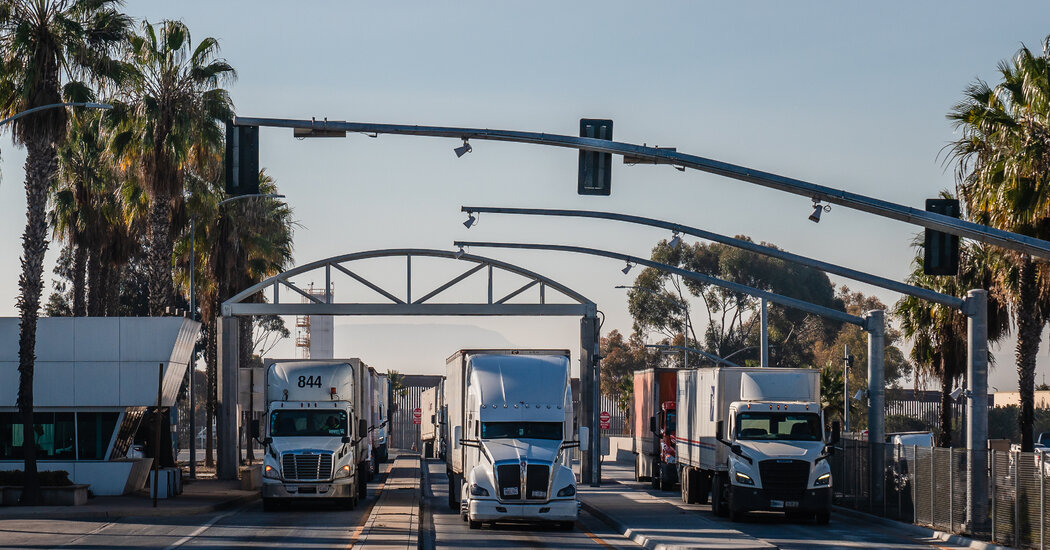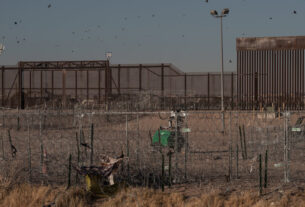Tariffs on imports from Canada and Mexico would go into effect on March 4 “as scheduled,” President Trump said on Thursday morning, claiming that those countries were still not doing enough to stop the flow of drugs into the United States.
China will also face an additional 10 percent tariff next week, on top of the 10 percent he imposed earlier this month, the president wrote in a post on Truth Social.
“Drugs are still pouring into our Country from Mexico and Canada at very high and unacceptable levels,” he said. “A large percentage of these Drugs, much of them in the form of Fentanyl, are made in, and supplied by, China.” He added that the levies were necessary until the flow of drugs “stops, or is seriously limited.”
In an effort to stem the flow of migrants and drugs, Mr. Trump threatened to impose tariffs on all products from Canada, Mexico and China in early February. But after Mexico and Canada promised measures like sending more troops to the border and, in the case of Canada, appointing a “fentanyl czar,” Mr. Trump paused their tariffs for one month.
He moved ahead with imposing a 10 percent tariff on all products from China, on top of those already in place, which prompted China to retaliate with its own tariffs on American goods.
Additional tariffs on the country’s three biggest trading partners would only add to the economic strain that has begun to emerge from Mr. Trump’s flurry of actions. And his threats have posed a particular quandary for Canadian officials, who argue that fentanyl made in Canada has not posed an increasing threat to the United States.
Last year, U.S. Customs and Border Protection agents intercepted about 19 kilograms of fentanyl at the U.S.-Canadian border, compared with almost 9,600 kilograms at the border with Mexico, where cartels mass-produce the drug. A 2020 Congressional commission that looked into reducing the flow of drugs into the United States found that Canada was not known to be a major source of fentanyl or its precursor chemicals.
Mexico, in contrast, is a major source of fentanyl shipments. In recent months, the Mexican government has widened its operations against the Sinaloa state, with a burst of high-level arrests, drug lab busts and drug seizures rocking the operations of the Sinaloa Cartel there.
After Mr. Trump came to the brink of imposing a 25 percent tariff on Mexican exports earlier this month, Claudia Sheinbaum, Mexico’s president, dispatched 10,000 national guard troops to the border and sent hundreds more soldiers to Sinaloa state, a major hub of fentanyl trafficking, resulting in high level arrests and raids of drug labs.
It remains unclear if those efforts will be enough to mollify Mr. Trump. His post on Thursday appeared to be an attempt to clarify the timing for his various tariffs after his remarks at the White House on Wednesday sowed confusion about whether the March 4 levies had been delayed.
When asked about tariffs on Canada and Mexico on Wednesday, Mr. Trump said that they would proceed — but mentioned April 2, which is when he has said another batch of tariffs on various countries, which he has called reciprocal tariffs, would go into effect.
Some investors interpreted those remarks as a sign the president meant to continue delaying the tariffs related to drugs and migrants, and the value of the peso and the Canadian dollar increased. But a White House official on Wednesday clarified that the April 2 date referred to other tariffs, not those on Canada and Mexico.
“The April Second Reciprocal Tariff date will remain in full force and effect,” Mr. Trump wrote Thursday.
Vjosa Isai, Natalie Kitroeff and Paulina Villegas contributed reporting.





